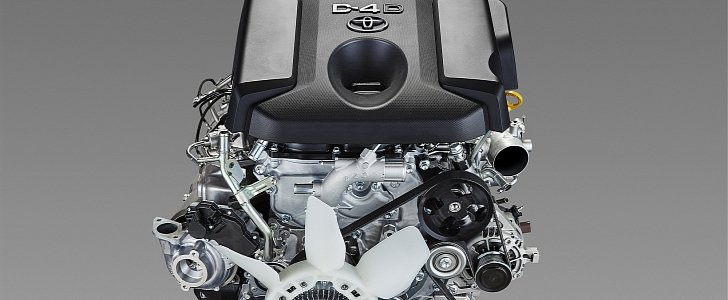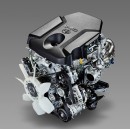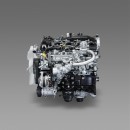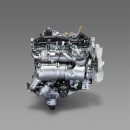One of the main problems engineers face with the internal combustion engine is upping its thermal efficiency. To the uninitiated, an engine with a thermal efficiency of 30% is losing 70% of the heat energy produced by the consumed gasoline, with 30% percent going into turning the engine’s crankshaft. In the case of the Toyota 2.8 D-4D turbo diesel engine, we’re talking about exceptional thermal efficiency.
According to in-house measurements, the all-new oil burner developed by the Japanese company isn’t just one of the most efficient turbo diesel engine out there, but it “represents the first fruits of advanced new design and technology to achieve much higher fuel efficiency, lower emissions, and quieter operation.” But does this statement actually hold water?
In a nutshell, it does. The next-generation thermal insulation diesel combustion technology from Toyota will debut on the Land Cruiser and Hilux, in 2.8-liter (1GD-FTV) and 2.4-liter (2GD-FTV) forms. The name of the game here is what the automaker calls Thermo Swing Wall Insulation Technology. Joined by a silica-reinforced porous and anodised aluminum coating on the pistons, the all-new tech reduces the cooling loss during the combustion cycle by 30% or so. But that’s not all there is to the new-generation D-4D engines.
Replacing the old 3-liter oil burner from the KD family of engines, the GD family boasts an air intake port that is shaped to allow better airflow into the cylinders. Highlights include advanced pressure and injection control for the common rail fuel injection system and a thoroughly revised combustion chamber shape. Toyota’s precise pilot injection tech matches the state of the ambient air, taking place ahead of the main injection sequence to shorten the ignition delay.
As for the turbocharging technology, the GD family employs an in-house developed variable geometry turbocharger that was developed to offer maximum torque over a wide engine rev range. Last but not least, the all-new D-4D generation of oil burners get a urea selective catalyst reduction system, a gizmo that reduces NOx emissions by up to 99 percent. This allows the engine to conform to Euro 6 standards.
With a compression ratio 15.6:1, the Toyota 1GD-FTV 2.8-liter and 2GD-FTV 2.4-liter produce 174 bhp (130 kW) at 3,400 rpm and 148 bhp (110 kW) at 1,200, respectively. In terms of torque, things get even better. From 1,200 rpm, the 2.8-liter boasts 370 Nm (273 lb-ft) and the 2.4-liter makes do with 330 Nm (243 lb-ft).
In terms of maximum torque, the 1GD-FTV produces 450 Nm (332 lb-ft) from 1,600 to 2,400 rpm and the 2GD-FTV develops 330 Nm (243 lb-ft) from 1,600 to 2,000 rpm. Compared to predecessors from the KD family, the GD engines are up to 25 percent more torquey and 15 percent more fuel efficient.
In a nutshell, it does. The next-generation thermal insulation diesel combustion technology from Toyota will debut on the Land Cruiser and Hilux, in 2.8-liter (1GD-FTV) and 2.4-liter (2GD-FTV) forms. The name of the game here is what the automaker calls Thermo Swing Wall Insulation Technology. Joined by a silica-reinforced porous and anodised aluminum coating on the pistons, the all-new tech reduces the cooling loss during the combustion cycle by 30% or so. But that’s not all there is to the new-generation D-4D engines.
Replacing the old 3-liter oil burner from the KD family of engines, the GD family boasts an air intake port that is shaped to allow better airflow into the cylinders. Highlights include advanced pressure and injection control for the common rail fuel injection system and a thoroughly revised combustion chamber shape. Toyota’s precise pilot injection tech matches the state of the ambient air, taking place ahead of the main injection sequence to shorten the ignition delay.
As for the turbocharging technology, the GD family employs an in-house developed variable geometry turbocharger that was developed to offer maximum torque over a wide engine rev range. Last but not least, the all-new D-4D generation of oil burners get a urea selective catalyst reduction system, a gizmo that reduces NOx emissions by up to 99 percent. This allows the engine to conform to Euro 6 standards.
With a compression ratio 15.6:1, the Toyota 1GD-FTV 2.8-liter and 2GD-FTV 2.4-liter produce 174 bhp (130 kW) at 3,400 rpm and 148 bhp (110 kW) at 1,200, respectively. In terms of torque, things get even better. From 1,200 rpm, the 2.8-liter boasts 370 Nm (273 lb-ft) and the 2.4-liter makes do with 330 Nm (243 lb-ft).
In terms of maximum torque, the 1GD-FTV produces 450 Nm (332 lb-ft) from 1,600 to 2,400 rpm and the 2GD-FTV develops 330 Nm (243 lb-ft) from 1,600 to 2,000 rpm. Compared to predecessors from the KD family, the GD engines are up to 25 percent more torquey and 15 percent more fuel efficient.






